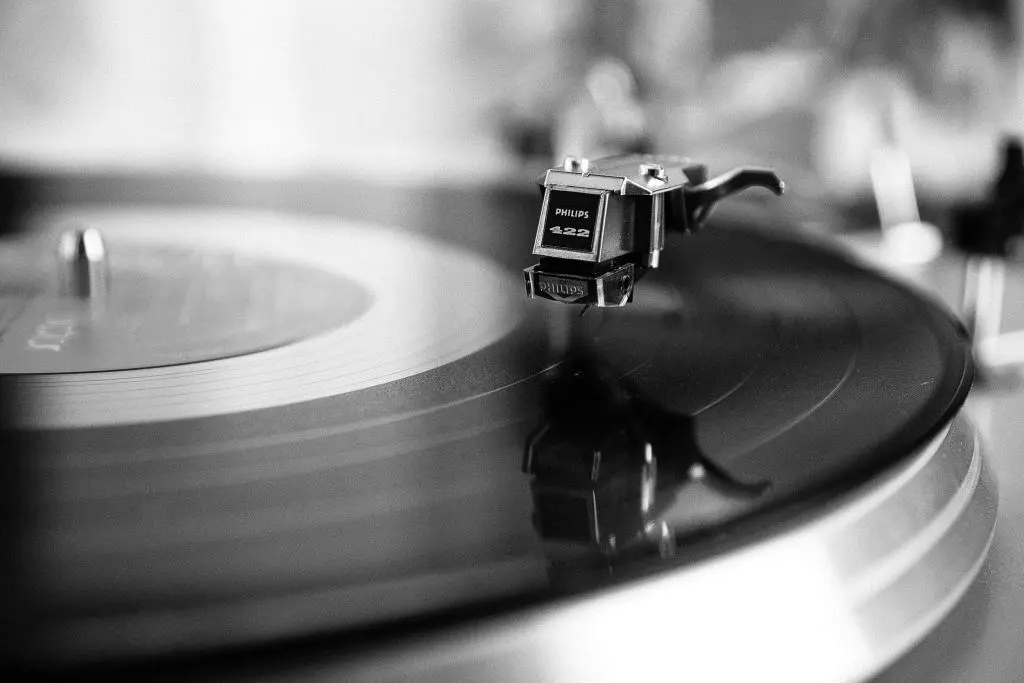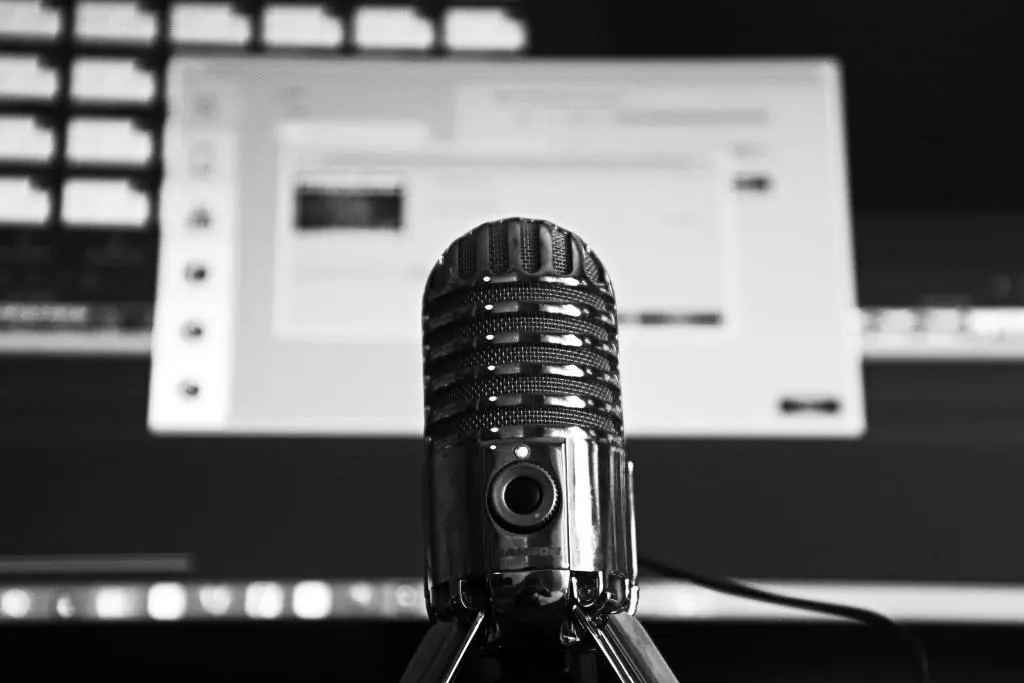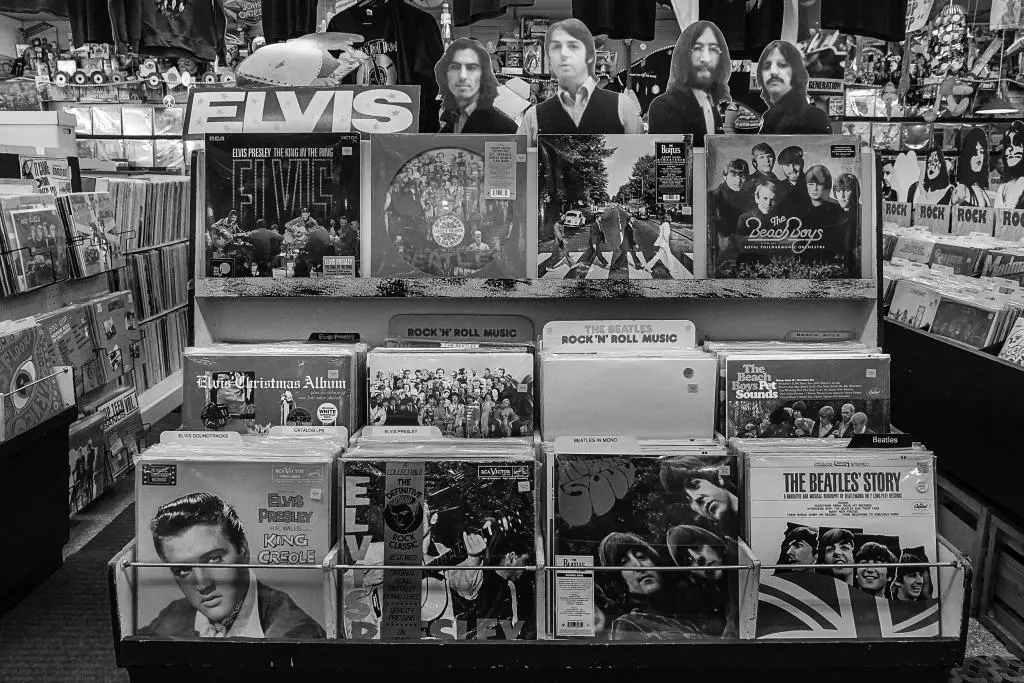Mono, short for monaural, is a term used in audio engineering and music production to describe sound that is intended to be heard as if it were emanating from a single position.

What is Mono: Table of Contents
In a mono recording, all the sound elements, including vocals, instruments, and other audio sources, are mixed down to a single channel. This single channel is then played through both speakers or headphones, creating a centered sound image. As a result, the listener hears the same audio in both ears, regardless of their position relative to the speakers or headphones.
Mono audio is characterized by its simplicity, consistency, and compatibility with a wide range of playback devices. It is often used in situations where stereo sound is not necessary or practical, such as in radio broadcasts, public address systems, and some older recordings.
The Rise and Fall of Mono Audio: A Brief History of Mono
The history of mono audio is a fascinating journey that spans over a century, beginning with the earliest days of sound recording and reproduction. It is a story of technological innovation, artistic experimentation, and the evolution of audio formats.
In the late 19th century, inventors like Thomas Edison and Emile Berliner were at the forefront of developing phonographs and gramophones that could record and play back sound using a single channel. These early devices used mechanical means to capture and reproduce sound. A stylus would trace the grooves of a rotating disc or cylinder, converting the vibrations into electrical signals that were then amplified and played back through a speaker. The resulting audio was monaural, or mono, meaning it was recorded and reproduced using a single channel. This was a revolutionary development, as it allowed sound to be captured, stored, and played back for the first time in history.
Mono sound became the standard for audio recording and reproduction for several decades. It was used in a wide range of applications, from early phonograph records to radio broadcasts. The simplicity and affordability of mono recording equipment made it accessible to a broad audience, and it played a crucial role in popularizing recorded music.
In the 1920s and 1930s, advancements in microphone technology and electrical recording techniques allowed for more accurate and detailed sound capture. The introduction of the ribbon microphone, for example, provided a more natural and realistic sound quality. Electrical recording, which used microphones to convert sound waves into electrical signals, replaced the earlier mechanical recording methods. These innovations led to significant improvements in audio fidelity and clarity. However, even with these advancements, mono remained the dominant format for audio recording and playback.
It wasn’t until the 1950s that stereo sound, which uses two separate audio channels to reproduce sound from two microphones on the right and left side, began to gain popularity. Stereo recording was first introduced in the film industry to enhance the cinematic experience. It provided a sense of spatial depth and directionality that mono could not achieve, creating a more immersive and realistic soundstage. The success of stereo sound in films eventually led to its adoption in the music industry.
Despite the rise of stereo sound, mono audio continued to be widely used in certain applications. AM radio stations, for example, continued to broadcast in mono due to the limitations of the AM frequency band. Mono records were also produced alongside stereo records for several years, as many people still owned mono record players that were incapable of playing stereo records. The transition from mono to stereo was gradual, and both formats coexisted for some time.
In the 1960s and 1970s, some artists and producers chose to work in mono, either in recognition of the technical limitations of the equipment of the era or because of personal preference. For example, The Beatles’ first four albums were released in both mono and stereo versions, with slight differences between the two. The mono mixes were often considered superior, as they were crafted with greater care and attention to detail. Mono LP records were eventually phased out and no longer manufactured after the early 1970s, with a few exceptions.
Today, mono audio is still used in specific applications, such as radiotelephone communications, telephone networks, and audio induction loops for use with hearing aids. It remains an important part of the history of audio recording and reproduction, and its legacy can still be heard in modern music and audio production. Mono audio has left an indelible mark on the world of sound, and its contributions to the art and science of audio recording will always be remembered.
Mono 101: Getting to Know Monaural Audio
Mono and stereo are two of the most common audio formats used in music production and sound recording. The primary difference between them lies in the number of audio channels they use. Mono, short for monaural, uses a single audio channel, while stereo, short for stereophonic, uses two separate audio channels.
In a mono recording, all the sound elements are mixed down to a single channel. This means that the same audio signal is played through both speakers or headphones, creating a centered sound image. The listener hears the same audio in both ears, regardless of their position relative to the speakers or headphones.
In contrast, a stereo recording uses two separate audio channels to reproduce sound from two microphones on the right and left side. This creates a sense of spatial depth and directionality, as the listener can perceive the position of different sound sources within the soundstage. For example, in a stereo recording of a live concert, the listener might hear the lead singer’s voice coming from the center, the guitar from the left, and the drums from the right.
Applications of Mono and Stereo
Mono and stereo audio formats have different applications, depending on the context and the desired listening experience.
Mono audio is often used in situations where stereo sound is not necessary or practical. For example, radio broadcasts, public address systems, and some older recordings typically use mono audio. Mono is also preferred in certain musical genres, such as early rock and roll, where the focus is on the overall sound rather than the spatial positioning of individual instruments.
Stereo audio, on the other hand, is widely used in modern music production, film soundtracks, and video games. It provides a more immersive and realistic listening experience, as it can create a sense of spatial depth and directionality. Stereo sound is especially effective in conveying the ambiance and atmosphere of a live performance or a specific location.
Mono vs. Multichannel Audio
Multichannel audio is an extension of stereo sound that uses more than two audio channels to create an even more immersive and realistic listening experience. The most common multichannel audio formats are 5.1 and 7.1 surround sound, which use five and seven audio channels, respectively, plus a subwoofer channel for low-frequency effects.
In a multichannel audio recording, each audio channel corresponds to a specific speaker position within the soundstage. This allows for a more precise and detailed spatial positioning of sound sources, creating a three-dimensional sound field that envelops the listener.
Mono audio, in contrast, uses a single audio channel and creates a centered sound image. It does not provide the same sense of spatial depth and directionality as multichannel audio. However, mono audio is simpler and more consistent, as it plays the same audio through both speakers or headphones, regardless of the listener’s position.
Applications of Mono and Multichannel Audio
Mono and multichannel audio formats have different applications, depending on the context and the desired listening experience.
Mono audio is often used in situations where spatial depth and directionality are not essential, such as radio broadcasts, public address systems, and some older recordings. It is also preferred in certain musical genres and artistic contexts where the focus is on the overall sound rather than the spatial positioning of individual instruments.
Multichannel audio, on the other hand, is widely used in modern film soundtracks, video games, and home theater systems. It provides a more immersive and realistic listening experience, as it can create a three-dimensional sound field that envelops the listener. Multichannel audio is especially effective in conveying the ambiance and atmosphere of a specific location or creating a sense of movement and dynamism within the soundstage.
Mastering Mono: How to Create a Centered Sound Image in Audio Production
Creating a mono recording involves mixing down all the sound elements to a single channel. This process combines vocals, instruments, and other audio sources into a unified sound that is played through both speakers or headphones, creating a centered sound image.
Combining Vocals and Instruments
In a mono mix, the vocals and instruments are combined into a single audio channel. This is achieved by adjusting the levels of each sound source to create a balanced and cohesive mix. The goal is to ensure that each element is clearly audible and that no single element dominates the mix. This process requires careful attention to detail, as the mixing engineer must consider factors such as frequency range, dynamics, and tonal balance. The final mix should sound full and rich, with a clear and focused sound image.
Creating a Balanced Mono Mix: How to Combine Vocals and Instruments
In a mono mix, all the sound elements are center-panned, meaning they are positioned in the center of the soundstage. This creates a centered sound image, where the listener hears the same audio in both ears, regardless of their position relative to the speakers or headphones. Center-panning is achieved by adjusting the pan controls on the mixing console or digital audio workstation (DAW) to the center position. This ensures that the audio signal is equally distributed to both the left and right channels of the stereo output.
Mastering Mono: How to Polish and Prepare Your Mono Recordings for Distribution
Mastering is the final step in the audio production process, where the mixed recording is polished and prepared for distribution. Mastering a mono recording involves transferring the final mix to a one-track lathe for vinyl pressing or preparing it for digital distribution.
The process of mastering a mono recording begins with a careful review of the final mix. The mastering engineer listens to the recording and makes adjustments to the overall tonal balance, dynamics, and equalization. This ensures that the recording sounds consistent and cohesive across different playback systems.
Once the final mix has been polished, it is transferred to a one-track lathe for vinyl pressing. The lathe is equipped with a cutting stylus that etches the audio signal into the vinyl surface. The resulting record contains a single audio channel, which is played back through both speakers or headphones, creating a centered sound image.
In the case of digital distribution, the mastered mono recording is prepared for release on various digital platforms. This may involve converting the recording to different file formats, such as MP3 or WAV, and ensuring that the audio quality is optimized for streaming and download.
Mastering a mono recording requires a keen ear and a deep understanding of audio production techniques. The mastering engineer must consider factors such as frequency range, dynamics, and tonal balance to achieve the perfect sound. The goal is to create a recording that sounds full and rich, with a clear and focused sound image.

Transferring Mono Recordings to a One-Track Lathe for Vinyl Pressing
Transferring a mastered mono recording to a one-track lathe is a crucial step in the production of vinyl records. The lathe is a specialized machine that cuts the audio grooves into the vinyl disc, creating a physical representation of the audio signal. The resulting record contains a single audio channel, which is played back through both speakers or headphones, creating a centered sound image.
The process begins with the mastered mono recording, which has been carefully polished and prepared for distribution. The recording is transferred to the lathe, which is equipped with a cutting stylus that etches the audio signal into the vinyl surface. The stylus moves in a spiral pattern, starting from the outer edge of the disc and moving towards the center. As the stylus moves, it cuts the audio grooves into the vinyl, creating a physical representation of the audio signal.
The depth and width of the grooves are determined by the amplitude and frequency of the audio signal. Louder sounds create deeper grooves, while higher frequencies create narrower grooves. The spacing between the grooves is also carefully controlled to ensure that the stylus can accurately track the grooves during playback.
Once the grooves have been cut, the vinyl disc is inspected for any defects or imperfections. Any necessary adjustments are made, and the disc is then ready for pressing. The vinyl disc is placed in a hydraulic press, which applies heat and pressure to create a finished record. The record is then cooled and trimmed to the desired size.
The resulting vinyl record contains a single audio channel, which is played back through both speakers or headphones, creating a centered sound image. This is characteristic of mono recordings, which use a single audio channel to create a unified and focused sound. The process of transferring a mastered mono recording to a one-track lathe is a delicate and precise operation that requires skill and expertise. The final result is a vinyl record that captures the warmth and authenticity of the original recording.
Playback on Stereo and Multi-Track Formats
Mono recordings can also be played back on stereo and multi-track formats. When a mono recording is played on a stereo system, the same audio signal is sent to both the left and right speakers, creating a centered sound image. Similarly, when a mono recording is played on a multi-track system, the audio signal is distributed to all the speakers, creating a unified sound field. This ensures that the listener hears the same audio in both ears, regardless of their position relative to the speakers or headphones.
Advantages of Mono Audio
Mono audio, short for monaural, is a method of sound reproduction that uses a single audio channel. Despite the rise of stereo and multichannel audio formats, mono audio still has several advantages that make it a valuable tool in certain situations.
Simplicity in Mono Audio
One of the primary advantages of mono audio is its simplicity. Mono recordings are easier to produce and require less equipment than stereo or multichannel recordings.
Streamlined Production with Mono
Producing a mono recording is a straightforward process. All the sound elements, including vocals, instruments, and other audio sources, are mixed down to a single channel. This eliminates the need for complex panning and balancing of multiple audio channels. As a result, mono recordings are easier to produce, making them more accessible for beginners and those working with limited resources.
Minimal Equipment Needed for Mono Recording
Mono recordings require less equipment than stereo or multichannel recordings. A single microphone and a basic recording setup are sufficient to capture a mono recording. This makes mono audio an affordable option for those working with a limited budget or in a minimalist recording environment.
Consistency of Mono Audio
Another advantage of mono audio is its consistency. Since mono audio is played through both speakers or headphones, the listener hears the same audio regardless of their position relative to the speakers.
Uniform Audio Experience with Mono
In a mono recording, all the sound elements are mixed down to a single channel. This means that the same audio signal is played through both speakers or headphones, creating a centered sound image. As a result, the listener hears the same audio in both ears, regardless of their position relative to the speakers or headphones. This consistency is especially useful in situations where the listener may be moving around, such as in a public address system.
Mono Audio: Ideal for Public Address Systems
Mono audio is often used in public address systems, such as those found in airports, train stations, and sports stadiums. In these situations, it is important that the audio is clearly audible and consistent throughout the entire space. Mono audio ensures that the listener hears the same audio regardless of their position, making it an ideal choice for public address systems.
Compatibility of Mono Audio
Mono audio is compatible with a wide range of playback devices, including older equipment that may not support stereo or multichannel audio.
Versatility of Mono Audio Playback
Mono audio can be played back on a wide range of devices, from modern smartphones and computers to vintage record players and radios. This makes mono audio a versatile format that can be enjoyed by listeners with different playback equipment.
Mono Audio: Perfect for Vintage Equipment
Mono audio is particularly suitable for older equipment that may not support stereo or multichannel audio. Many vintage record players, radios, and amplifiers are designed for mono audio playback. By using mono audio, listeners can enjoy a consistent and high-quality listening experience on their older equipment.
Focused Sound with Mono Audio
In some cases, mono audio can create a more focused and direct sound image, which may be desirable for certain types of recordings.
Direct and Centered Sound with Mono
Mono audio creates a centered sound image, where all the sound elements are mixed down to a single channel. This creates a focused and direct sound image that can be more impactful and engaging for the listener. In certain musical genres, such as early rock and roll, the focus and directness of mono audio can enhance the overall listening experience.
Mono Audio: A Choice for Specific Recordings
Some artists and producers prefer the focused and direct sound image of mono audio for certain recordings. For example, early Beatles albums were released in both mono and stereo versions, with the mono mixes often considered superior. Mono audio can create a more intimate and immediate listening experience, making it a desirable choice for certain recordings.
Limitations of Mono Audio
While mono audio has several advantages, it also has some limitations that can affect the listening experience. These limitations include a lack of spatial depth, limited mixing options, and reduced audio quality.
Mono Audio and the Absence of Spatial Depth
One of the main limitations of mono audio is its lack of spatial depth. Since mono audio uses a single audio channel, it does not provide the same sense of spatial depth and directionality as stereo or multichannel audio.
Mono Audio: Less Immersive Listening Experience
Mono audio creates a centered sound image, where all the sound elements are mixed down to a single channel. This can make the listening experience less immersive and engaging, as the listener does not perceive the position of different sound sources within the soundstage. In contrast, stereo and multichannel audio create a sense of spatial depth and directionality, providing a more immersive and realistic listening experience.
Directionality Lacking in Mono Audio
Mono audio does not provide any sense of directionality, as all the sound elements are center-panned. This means that the listener hears the same audio in both ears, regardless of their position relative to the speakers or headphones. In contrast, stereo and multichannel audio use multiple audio channels to create a sense of directionality, allowing the listener to perceive the position of different sound sources within the soundstage.
Mono Audio’s Limited Mixing Options
Another limitation of mono audio is its limited mixing options. Since all the sound elements are mixed down to a single channel, there are fewer options for creating a balanced and dynamic mix.
Challenges in Achieving a Balanced Mix with Mono
In a mono mix, all the sound elements are combined into a single audio channel. This limits the mixing engineer’s options for creating a balanced mix, as they cannot adjust the levels and panning of individual audio channels. As a result, it can be more challenging to achieve a balanced and cohesive mix in mono audio.
Mono Audio’s Less Dynamic Mix
Mono audio also limits the mixing engineer’s options for creating a dynamic mix. Since all the sound elements are mixed down to a single channel, there are fewer options for adjusting the dynamics and tonal balance of the mix. This can make the final mix less dynamic and less engaging for the listener.
Reduced Audio Quality in Mono
In some cases, mono audio may have a lower audio quality than stereo or multichannel audio. This can be due to the limitations of the recording equipment or the mixing process.
Mono Audio’s Lower Quality Compared to Stereo or Multi-Channel
Mono audio uses a single audio channel, which can result in a lower audio quality than stereo or multichannel audio. Stereo and multichannel audio use multiple audio channels to create a sense of spatial depth and directionality, providing a more immersive and realistic listening experience. In contrast, mono audio creates a centered sound image, which can make the listening experience less immersive and engaging.
Mono Audio Quality Depends on Recording Equipment
The quality of a mono recording depends on the quality of the recording equipment. If the recording equipment is not of high quality, the resulting mono audio may have a lower audio quality than stereo or multichannel audio. This can affect the clarity, fidelity, and overall listening experience of the mono recording.

Applications of Mono Audio
Mono audio, short for monaural, is a method of sound reproduction that uses a single audio channel. Despite the rise of stereo and multichannel audio formats, mono audio still has several applications where it is the preferred or necessary format.
Radio Broadcasts
Radio broadcasts are one of the most common applications of mono audio. Many radio stations, especially AM radio stations, continue to broadcast in mono due to the limitations of the AM frequency band.
AM Radio Stations
AM radio stations typically broadcast in mono due to the limitations of the AM frequency band. The AM frequency band has a narrower bandwidth than the FM frequency band, which makes it less suitable for stereo broadcasting. Mono audio is more compatible with the AM frequency band and provides a more consistent and clear listening experience for AM radio listeners.
FM Talk-Radio Stations
Some FM talk-radio stations also broadcast in mono, as talk-radio content does not require the spatial depth and directionality provided by stereo audio. Mono audio is sufficient for talk-radio content, as it provides a clear and focused sound image that is suitable for spoken word content.
Public Address Systems
Public address systems, such as those found in airports, train stations, and sports stadiums, often use mono audio. In these situations, it is important that the audio is clearly audible and consistent throughout the entire space. Mono audio ensures that the listener hears the same audio regardless of their position, making it an ideal choice for public address systems.
Audio Induction Loops for Hearing Aids
Audio induction loops are used to transmit audio signals directly to hearing aids, allowing hearing-impaired individuals to hear more clearly in noisy environments. These systems often use mono audio, as it provides a clear and focused sound image that is suitable for hearing aids. Mono audio is also more compatible with the limited bandwidth of audio induction loops.
Older Recordings
Many older recordings, especially those made before the 1960s, were recorded in mono. These recordings were made using a single microphone and were mixed down to a single audio channel. As a result, they have a centered sound image and lack the spatial depth and directionality of stereo recordings. Mono audio is still used to play back these older recordings, as it provides a more authentic and accurate listening experience.
Artists and Mono Recordings
Mono audio, short for monaural, has a rich history in the world of music recording. Despite the rise of stereo and multichannel audio formats, some artists and producers have chosen to work in mono, either in recognition of the technical limitations of the equipment of the era or because of personal preference.
Preference for Mono
Some artists and producers prefer the focused and direct sound image of mono audio for certain recordings. This preference can be due to the recognition of the technical limitations of the equipment of the era or simply a personal preference for the sound of mono audio.
Recognition of Technical Limitations
In the 1960s and 1970s, some artists and producers chose to work in mono in recognition of the technical limitations of the equipment of the era. At the time, stereo recording equipment was still relatively new and expensive, and not all studios had access to it. Additionally, many listeners still owned mono record players that were incapable of playing stereo records. As a result, some artists and producers chose to work in mono to ensure that their recordings would be compatible with the widest range of playback equipment.
Simple Preference
Some artists and producers simply prefer the sound of mono audio. Mono audio creates a centered sound image, where all the sound elements are mixed down to a single channel. This creates a focused and direct sound image that can be more impactful and engaging for the listener. In certain musical genres, such as early rock and roll, the focus and directness of mono audio can enhance the overall listening experience.

Examples of Artists Using Mono
Several artists have chosen to work in mono, either in recognition of the technical limitations of the equipment of the era or because of personal preference.
The Beatles’ Early Albums
The Beatles’ first four albums were released in both mono and stereo versions, with slight differences between the two. The mono mixes were created first, and the stereo mixes were created later by splitting the mono mixes into two channels and adding some additional effects. The mono mixes are considered by many to be superior, as they were the mixes that The Beatles and their producer, George Martin, intended. The mono mixes have a more balanced and cohesive sound, as all the sound elements are mixed down to a single channel. The stereo mixes, on the other hand, have a more separated and artificial sound, as the sound elements are split between two channels.
Bob Dylan’s “The Freewheelin’ Bob Dylan”
Bob Dylan’s second studio album, “The Freewheelin’ Bob Dylan,” was originally released in both mono and stereo versions in 1963. The mono version is considered by many to be superior, as it has a more focused and direct sound. The stereo version, on the other hand, has a more separated and artificial sound, as the vocals and instruments are panned hard left and right.
The Rolling Stones’ “Aftermath”
The Rolling Stones’ fourth studio album, “Aftermath,” was released in both mono and stereo versions in 1966. The mono version is considered by many to be superior, as it has a more balanced and cohesive sound. The stereo version, on the other hand, has a more separated and artificial sound, as the vocals and instruments are panned hard left and right.
The Beach Boys’ “Pet Sounds”
The Beach Boys’ eleventh studio album, “Pet Sounds,” was originally released in both mono and stereo versions in 1966. The mono version is considered by many to be superior, as it was the mix that Brian Wilson, the album’s producer, intended. The mono mix has a more balanced and cohesive sound, as all the sound elements are mixed down to a single channel. The stereo mix, on the other hand, has a more separated and artificial sound, as the sound elements are split between two channels.
The Who’s “My Generation”
The Who’s debut studio album, “My Generation,” was originally released in both mono and stereo versions in 1965. The mono version is considered by many to be superior, as it has a more focused and direct sound. The stereo version, on the other hand, has a more separated and artificial sound, as the vocals and instruments are panned hard left and right.
John Mellencamp’s “No Better Than This”
John Mellencamp’s 2010 album “No Better Than This” was recorded entirely in mono. Mellencamp chose to work in mono to capture the raw and authentic sound of early rock and roll. The album was recorded using a single microphone and a vintage 1955 Ampex tape recorder, and the resulting recordings have a warm and natural sound that is characteristic of mono audio.

Modern Use of Mono
Mono audio, short for monaural, has a rich history in the world of music recording. Despite the rise of stereo and multichannel audio formats, mono audio still has a place in modern music production. One of the most notable uses of mono audio in recent years is the remastering of classic albums in their original mono format.
Remastered Mono Albums
Many classic albums that were originally recorded in mono have been remastered and reissued in their original mono format. These remastered mono albums provide a more authentic and accurate listening experience, as they preserve the original sound and mix of the albums.
The Beatles in Mono
In 2009, The Beatles’ entire catalog of studio albums was remastered and reissued in both stereo and mono formats. The mono versions of the albums were released in a box set called “The Beatles in Mono.” The mono versions of the albums are considered by many to be superior, as they were the mixes that The Beatles and their producer, George Martin, intended. The mono mixes have a more balanced and cohesive sound, as all the sound elements are mixed down to a single channel. The stereo mixes, on the other hand, have a more separated and artificial sound, as the sound elements are split between two channels.
The Original Mono Recordings by Bob Dylan
In 2010, Bob Dylan’s first eight studio albums were remastered and reissued in their original mono format in a box set called “The Original Mono Recordings.” The mono versions of the albums are considered by many to be superior, as they have a more focused and direct sound. The stereo versions of the albums, on the other hand, have a more separated and artificial sound, as the vocals and instruments are panned hard left and right.
The Kinks in Mono
In 2016, The Kinks’ entire catalog of studio albums from the 1960s was remastered and reissued in their original mono format in a box set called “The Kinks in Mono.” The mono versions of the albums are considered by many to be superior, as they have a more balanced and cohesive sound. The stereo versions of the albums, on the other hand, have a more separated and artificial sound, as the vocals and instruments are panned hard left and right.
Final Thoughts: Continued Relevance of Mono Audio
Despite the rise of stereo and multichannel audio formats, mono audio still has a place in modern music production. Many classic albums that were originally recorded in mono have been remastered and reissued in their original mono format. These remastered mono albums provide a more authentic and accurate listening experience, as they preserve the original sound and mix of the albums. Mono audio is also still used in specific applications, such as radiotelephone communications, telephone networks, and audio induction loops for use with hearing aids. It remains an important part of the history of audio recording and reproduction, and its legacy can still be heard in modern music and audio production.

Frequently Asked Questions About Mono Audio
Mono audio can seem confusing at first glance. What exactly is it? How does it differ from stereo? What are the advantages and limitations? This FAQ guide answers the most frequently asked questions about mono sound. Whether you are new to audio production or simply looking to brush up on the fundamentals, this resource covers all the key questions in detail. Read on for clear explanations of mono audio principles, applications, history and more. By the end, all your top questions will be answered and you’ll have a solid grasp of this fundamental audio format.
What is Mono Audio?
Mono audio, short for monaural or monophonic, refers to a single audio channel for playback or recording. It is a method of sound reproduction where audio signals are combined into a single channel, creating a centered sound image.
When is Mono Audio Used?
Mono audio is often used in situations where stereo sound is not necessary or practical, such as in radio broadcasts, public address systems, and some older recordings.
What is the Difference between Mono and Monaural Audio?
There is no difference between mono and monaural audio. Both terms refer to a single audio channel for playback or recording.
Does Mono Audio play in Both Ears?
Yes, mono audio plays the same content in both ears, creating a centered sound image.
Is Mono Audio better for Phone Speakers?
Mono audio is often preferred for phone speakers because it provides a clear and concise sound, especially when there is only one speaker.
Why is Mono Audio Still Relevant Today?
Mono audio remains relevant due to its simplicity, consistency, and compatibility. It is still widely used in radio broadcasts, public address systems, and older recordings. Mono audio is also preferred in situations where stereo sound is not necessary or practical.
How Does Mono Audio Impact the Listening Experience?
Mono audio creates a centered sound image, providing a more focused and direct listening experience. However, it lacks spatial depth and directionality, which can make it less immersive and engaging compared to stereo or multi-channel audio.
Is Mono Audio Suitable for Modern Music Production?
Mono audio can be suitable for modern music production, especially for recordings that require a clear and focused sound. It is often used for vocals, percussion, and other elements that need to be centered in the mix.
Can Mono Audio Enhance Vocal Clarity in Recordings?
Yes, mono audio can enhance vocal clarity by providing a more focused and direct sound. It eliminates the spatial effects of stereo audio, making it easier to understand the lyrics and nuances of the voice.
Is Mono Audio the Right Choice for Live Performances?
Mono audio can be the right choice for live performances in certain situations, such as when the audience is spread out over a large area or when the sound system has limited stereo capabilities. It ensures that everyone hears the same audio regardless of their position.
Why Do Some Podcasters Prefer Mono Audio?
Some podcasters prefer mono audio because it provides a consistent listening experience on various playback devices. It also requires less bandwidth and storage space, making it more accessible for listeners with limited internet connectivity.
Can Mono Audio Create a More Focused Soundstage?
Yes, mono audio can create a more focused soundstage by providing a centered sound image. It eliminates the spatial effects of stereo audio, creating a more direct and immediate listening experience.
Is Mono Audio Suitable for Binaural Recordings?
Mono audio is not suitable for binaural recordings, which require two separate audio channels to create a three-dimensional listening experience. Binaural recordings are typically recorded using stereo or multi-channel audio.

